WEDNESDAY
JANUARY 31 - 2018
Hollybank
Woods
I had an hour
to spare this morning so I decided to try out my new
Derry boots for a walk in Hollybank Woods. It was
certainly very wet, but the boots were excellent.
Incidentally this is now my 4th pair in about 20
years. I parked on Emsworth Common Road and did a
short circuit in the north-east sector. I have not
been in the woods for a few months and it was so good
to walk along the eastern bridleway with the trees
glistening and the birds singing, notably Robin and
Great Tit.

There were masses of
Sweet Chestnut husks beneath the trees,
indicating a bumper autumn harvest which I missed.

Young Andrew was not
in his usual work area, but he is still very busy
cutting stakes, etc. He also has erected a gazebo to
shelter from the rain since I was last here.

Wandering around this
area, I noted plenty of bright green Bank
Haircap moss which I can identify.

Nearby I found another
green moss (or liverwort?) with crinkly edged leaves
growing on a dead twig which I recognised as familiar,
but could not identify. My very tentative guess is
Marchantia polymorpha though I would
appreciate help.

Return
of the winter Blackcaps
It is now well
known that a population of Blackcaps over winter in UK
gardens and research evidence provided by the BTO
Garden BirdWatch scheme has established a firm link
between increased in Blackcaps over wintering to both
garden feeding and warmer temperatures. See . . .
https://bto-enews.org/NXK-5CCTM-3UEDCR-2ZGQNB-0/c.aspx
More recently, there
was excitement in November when a Blackcap fitted with
a tiny tracking device was recaptured by Glynne Evans
in his Hampshire garden where it was tagged nine
months earlier. Preliminary analysis of the tag data
indicates that the bird left Britain at the end of
March and spent the summer in France, before returning
by early November. But is this pattern the exception,
or the rule? And why did this bird decide to come
north for the winter when it was already in southern
France? BTO hope to find the answers to these
questions and many others as the project continues.
See . . . https://bto-enews.org/NXK-5CCTM-3UEDCR-2ZGQNA-0/c.aspx
For a general summary
of this fascinating project on the movement of
Blackcaps organised by BTO, and Oxford and Exeter
Universities see . . . https://bto-enews.org/NXK-5CCTM-3UEDCR-2ZGQNC-0/c.aspx
Personally, I have not
seen any wintering Blackcaps in my Emsworth garden,
though I certainly have had them in previous years.
However, Barrie Jay has had a female in his
Waterlooville garden - see blog for Jan 22.

TUESDAY
JANUARY 30 - 2018
Nore
Barn
I had a walk
around Nore Barn this afternoon. The tide was right
out, so no chance of Spotted Redshank. I walked along
the north path looking in vain for Firecrests. Came
back through the woods where Robin and Great Tit were
singing strongly. Coming back along the south path, my
attention was attracted by a small group of Brent
Geese feeding quietly on the shore, so took a few
snaps.

Avocets
Eric Eddles
popped up to where the Great Salterns jetty once stood
on the west side of Langstone Harbour and saw these
two Avocets and a Spotted Redshank (no photo).

MONDAY
JANUARY 29 - 2018
Langstone
Mill Pond
Peter
Milinets-Raby managed to time a dry, but gloomy visit
to Langstone Mill Pond late this afternoon 3:50pm to
4:21pm - tide very low.
Off shore: The highlight was the sight of a huge Brent
Goose flock flying off the fields at Warblington and
landing on the muddy shore. I took several photos and
counted them at leisure at home. I could not see any
odd looking geese amongst them! 544 Brent Geese, 36
Lapwing, 16 Teal, A pair of Pintail, 5 Turnstone, 4
Grey Plover,
On Langstone Mill Pond: 1 singing Cetti's Warbler, 1
Teal, 2 Mute Swan.
In the flooded horse paddock - fast drying out: 32
Teal (see photo), 14 Moorhen, 1 Grey Heron, 4
Oystercatcher, 1 Green Sandpiper, 15 Magpie, 1 Buzzard
perched on one of the fence posts.

Spillage
in the Ems
On Saturday
Jan 27, Juliet Walker noticed what appeared to be an
spillage of oil in the River Ems just by the north
bridge. Very psychedelic and photogenic maybe, but not
good for wildlife.

The oil, if that is
what it was, has now gone, but we would appreciate any
information as to how it got into the river and where
it came from. Please contact Maurice Lillie at . . .
mauricelillie@gmail.com
SATURDAY
JANUARY 27 - 2018
Garden
Hawfinch
Jo Bray &
David Wagland did an hour's Big Garden Birdwatch this
morning in their Westbourne garden with some
interesting results. Although some of their 'regulars'
failed to appear, like Coal Tit, Long-tailed Tit and
Collared Dove, they were rewarded with two exceptional
birds .... Hawfinch and Redpoll! The Redpoll happily
shared the nyger seed feeder with the
Goldfinches

While the Hawfinch ate
sunflower seeds from the bird table.


The Redpoll is perhaps
not entirely unexpected, but to get a Hawfinch in the
garden is in my experience totally amazing! I have
certainly never seen a Hawfinch in my garden, nor have
I ever heard of anyone else seeing one. In fact, I
can't recall the last time I saw one anywhere!
However, a quick internet search indicated that there
has been an unprecedented influx of them into this
country this winter due, it is thought, to a seed crop
failure on the continent. So it might be worthwile
keeping a special look out for one in your garden - or
elsewhere! Read more at . . . http://ww2.rspb.org.uk/community/ourwork/b/natureshomemagazine/archive/2017/11/13/five-top-tips-for-seeing-a-hawfinch.aspx
Warblington
shore
Peter
Milinets-Raby I visited the Warblington shore this
morning 7:40am (8 minutes before sunrise) to 10:14am
high tide, slowing going out.
Warblington cemetery: Jay heard.
Ibis Field: 1 Moorhen, 2 Long-tailed Tits, Grey
Wagtail Heard,
Rotting wheat stems pile: 5 Meadow Pipit, 4 Pied
Wagtail, 3 Roe Deer and a Fox.
In field behind Conigar Point: 12 Skylark.
Conigar Point: 1 Little Egret feeding along the
shoreline (see photo),

41 Wigeon (nice and
close until dog walkers flushed the feeding flock (see
photos),

51 Brent Geese (one
juvenile in this flock), 40 Shelduck, 863 Dunlin
(amazing tight flock feeding on the first bit of
exposed mud), 29 Grey Plover, 1 Bar-tailed Godwit, 2
Red breasted Merganser.
Off Pook Lane: 270 Brent Geese, male and female
Goldeneye, 46 Wigeon, 65 Teal, 14 Shelduck, 4 Grey
Plover, 171 Dunlin.
Flooded Paddock north of Langstone Mill Pond: No
godwits, 11 Wigeon, 7 Oystercatcher, 1 Green
Sandpiper, 1 pretty and lonesome Curlew, 19 Teal, 11
Moorhen, 1 Redshank, 3 Grey Herons collecting sticks,
2 Foxes.
Langstone Mill Pond: 3 Teal,
Grey Heron colony: Five nests up and running, one with
possible young, two clearly sitting on eggs and the
other two not far from starting: Details below:
Top of Holm Oak: Looks like tiny chicks present, but
not seen. Male visited twice while I was there.
Lower down Holm Oak: Male bringing sticks to the nest,
female sitting on nest helping to rearrange
Other Holm Oak Very top nest on right side: adult
sitting tight on nest
Nest Number 9: Adult sitting tight on nest, just
forehead and bill sticking out - on eggs no doubt
Nest 10: Adult standing on this nest.
THURSDAY
JANUARY 25 - 2018
Firecrests
at Nore Barn
Peter
Milinets-Raby had already alerted me to the presence
of Firecrests along the path north of Nore Barn Woods,
so this afternoon at about 2pm I made my way there,
but, I must admit, more in hope than expectation of
seeing these tiny active birds whose voices are way
too high for my aged ears to pick up. Fortunately,
Peter was already in place on the path with his scope
and camera and as soon as I arrived he pointed out a
male Firecrest in a bush on the edge of the path.
Wonderful.
Peter told me he had found another male Firecrest
about 70 metres further along the path Peter found
along with 2 Goldcrests and 2 Long-tailed Tits. And
again, about 70 more metres further along by 2 or 3
small Holly trees by the path he had discovered an
active pair of Firecrest. Peter said these birds are
in great habitat and maybe tempted to stay to breed
and wouldn't that be exciting! So in total four birds.
A great record for this part of the world.
Here is Peter's
cracking photo of a male with flaming orange crown and
white 'eyebrow'.

Peter went off to
count the birds in the harbour while I mooched slowly
along the path stopping here and there to examine the
bushes. I saw at least another one Firecrest along the
path, plus a Goldcrest and Long-tailed Tits. Here is
my best effort at a Firecrest. It looks more like a
female with yellow crest and greenish back. At least
you can see what it is!

The Spotted
Redshank was a much easier bird to photograph in
the stream.

Harbour
birds
Here is
Peter's report of the birds in the harbour: Spotted
Redshank (regular bird) in the stream, 246 Wigeon, 79
Teal, 10 Pintail, 94 Brent Geese, 2 Shelduck, 18 Grey
Plover, 22 Turnstone, 10 Dunlin.
In the distance off Beacon Square were 285 Brent
Geese, 93 Wigeon, 1 male Pintail and 100+ Dunlin (did
not have time to count)
Colour-ringed
Godwit
Pete Potts
sent through details of the history of the
colour-ringed Black-tailed Godwit WNG+YRY that Peter
Milinets-Raby saw yesterday at Langstone.
It was ringed on 07-Feb-15 by the Axe Estuary Ringing
Group. It has been recorded many times subsequently in
the Solent area, mainly at Titchfield Haven. The last
sighting was on 27-Jul-16 at Titchfield Haven, so its
appearance in our local area was a bit out of the
blue.
WEDNESDAY
JANUARY 24 - 2018
Langstone
Mill Pond
Peter
Milinets-Raby had a very brief visit to Langstone Mill
pond late this afternoon 3:15pm to 3:45pm - still
drizzle and high tide.
Nothing on the pond except 2 Mute Swan, 40+ Mallard
and a single Little Egret. So concentrated on the
flooded paddock which is fast becoming a mini Avon
Valley.
52 Teal, 2 Little Egrets, 3 Grey Herons, 7
Oystercatcher, 1 Greenshank, 1, Redshank, 4 Wigeon,
185+ Black Headed Gulls, 7 Common Gulls, 1 nice
looking Curlew, 12 Moorhen, 1 Grey Wagtail and 22
Black tailed Godwit (including Ringed bird WNG//- +
YRY//- from the other day). Great stuff.
Brian's note: I don't know this colour-ringed
Black-tailed Godwit, but will ask Pete Potts.
TUESDAY
JANUARY 23 - 2018
Emsworth
Millpond
For my regular
constitutional, I had stroll around the town millpond
in light drizzle this morning. It was good to see the
regular Goosander on the pond, constantly diving and
accompanied by a small group of Black-headed Gulls, no
doubt hoping to snatch any bits the duck misses. This
is the 10th week that this handsome bird has been in
Emsworth since it was first sighted by Peter
Milinets-Raby on 16-Nov-17.

MONDAY
JANUARY 22 - 2018
Brook
Meadow
I donned my
wellies this afternoon for a rather squelchy walk
around Brook Meadow. Annoyingly, the deep puddles
revealed a leak in one of my boots which will need
replacing. However, it was an interesting, though
uneventful walk.
The view of the river from the north bridge is much
improved followed the clearance work on the bankside
by the conservation group. Maybe, it will help to
attract back our missing Water Voles.

More good work by the
conservation group can be seen in the two laid hedges
near the river which have been recently spruced-up.

Good to see the first
signs of Cow Parsley flowering on the Seagull
Lane patch with white buds starting to unfurl and the
first blossom on the Cherry Plum tree on the
causeway - which Roger Mills alerted me to a couple of
days ago.
Most of the Osier
twigs on the trees on the east side of the north
meadow have been removed by the conservation group for
hedging, but those remaining are showing catkins
opening. The new Alder sapling that was planted
by the group near the Lumley Stream a few years ago
has plenty of old cones from last year and new cones
forming for this year as well as new leaf buds.
There is a fresh
growth of Jew's Ear fungi on a dead stump of a
Crack Willow tree on the east side of the river. This
is a fairly common fungus on the meadow.

Finally, while walking
back up the main path a Kingfisher flew low up
the river towards the north bridge. I crept towards
the bridge and managed to get a few shots before it
flew off under the bridge. The photo shows the bird as
a male Kingfisher with all black mandibles; a female
would have a red lower mandible.

Garden
birds
I am very
envious of the birds that Barrie Jay sees in his
Waterlooville garden which include several that I
rarely see in my Emsworth garden. Here are some photos
he sent of the stars, all taken in the past week.
Barrie has a resident pair of Bullfinches but both are
male! No sign of females. He says Goldcrests are quite
common this winter - sometimes 3 at a time flitting
about! The female Blackcap was just a passing visitor.
Has anyone else had Blackcaps in the garden this
winter? A Song Thrush has taken up residency for the
winter.
SUNDAY
JANUARY 21 - 2018
Garden
birds
The past week
was a fairly average one for birds in my garden. I
recorded a total of 16 species as follows: Blackbird
2, Blue Tit 1, Chaffinch 6, Collared Dove 5, Dunnock
1, Goldfinch 9, Great Tit 1, Greenfinch 1, House
Sparrow 6, Long-tailed Tit 4, Magpie 1, Robin 2,
Starling 12, Stock Dove 1, Woodpigeon 3, Wren 1. I
also saw a Kestrel flying overhead, though I cannot
count this in the Garden BirdWatch scheme as it did
not land or obviously feed.
Long-tailed Tits
love the fat balls. Goldfinches always go for
sunflower hearts

The most interesting
bird of the week was the Stock Dove that
appeared today feeding with a Woodpigeon. I got a
photo through the window which shows the distinctive
iridescent neck with no collar, back eyes and short
dark bands on the inner wings. Up to last year Stock
Dove was a rare bird in my garden, not seen at all
until 2013, but 2017 was an exceptional year with
sightings on 9 weeks with a maximum of 2 at any one
time. Today's was the first sighting of 2018.

Emsworth
The Havant
Wildlife Group met in Bridge Road car park yesterday
(Jan 20) for their walk in Emsworth. I was sorry I was
not well enough to join them. However, despite the wet
weather they had a great time and Emsworth certainly
lived up to its rightful reputation as one of the best
birdwatching spots in the country! Here is Fay
Durant's report along with a few photos of the
highlights.
"Eight brave souls met
on a very grey, misty, damp morning at Bridge Road car
park. ( The venue had to be changed due to the state
of the terrain.) I had no great expectations of the
morning but it turned out to be quite exceptional . We
started off along the west shore of the mill pond,
noting how much cleaner it looked. There was the usual
collection of mallards , coots and swans then Ros saw
the flash of a Kingfisher and it landed on a
low branch of a bush, hanging down in front of the
pond wall and there it stayed for all to admire! Photo
by Steph Dale.
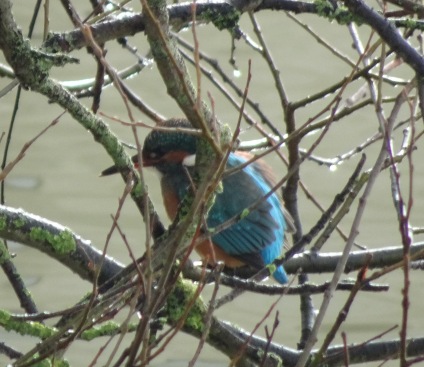
When we reached the
sailing club we turned west towards Nore Barn. The
tide was well out but a large group of dunlin were
noted, also wigeon, shelduck, pintails, oystercatchers
and a few grey plovers. Plenty of Brent geese, of
course. Later very good close ups of oystercatchers
and wigeon.
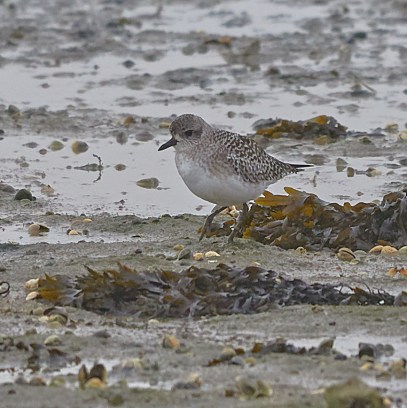
We approached the
famous stream where the spotted redshank was
slowly making its way to where we were. It seemed to
have no fear of us and came really close, walking
across the pebbles, providing an excellent opportunity
for good photographs.
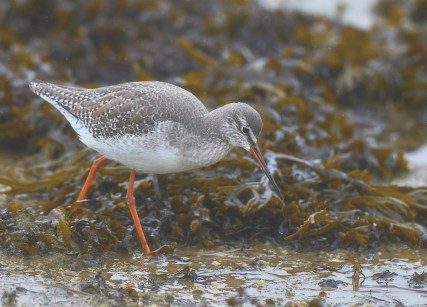
We proceeded further
along the shore and saw four black tailed godwits,
curlew, redshank, teal and on our return a great
crested grebe. As we turned inland, at the edge of the
wood, quick sighted Heather saw two birds flash by: a
goldcrest and a firecrest , the latter seldom seen.
Glimpses of these birds were seen again, further on,
and the firecrest actually flew up from our feet. We
stood by the gate leading to Warblington church and,
whilst looking for grey wagtail, a nuthatch was noted
on the thick branch of a tree, beside the stream. It
was busy throwing moss off the branch, looking for
insects. It remained for a long time.
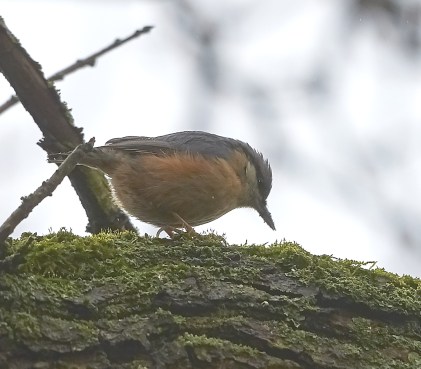
We walked a little way
up the path opposite and heard song thrush etc but no
sign of bullfinches. Walking back, eastwards, Heather
saw some greenfinches. We had seen numerous sparrows,
dunnocks, robins and blackbirds during the walk plus
blue tits, great tits, long tails, goldfinch, crows
and a wren. Later a sparrowhawk was seen diving in to
the woodland. We had a nice coffee break sitting by
the waters edge, with ducks etc in the background .
Photo by Sue of some of us gathering for coffee at
Nore Barn, left to right Stephanie, Heather, Fay and
Helen.
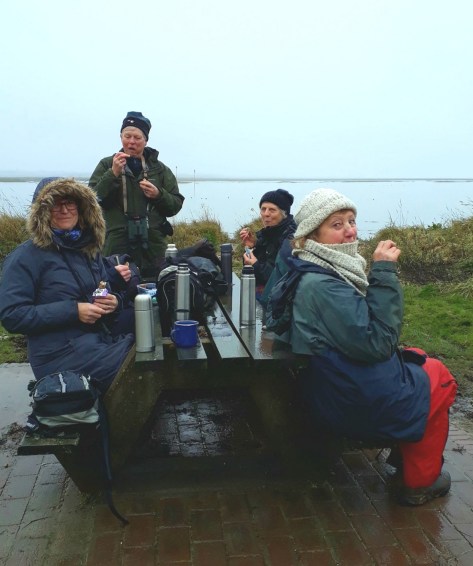
When we returned to
the mill pond we saw the elusive goosander and
another good siting of the kingfisher - twice in one
day!

Plus a dab chick. In
the wood we had seen a very nice bush of butchers
broom with red berries and one flower noted. Photo
by Heather from her phone.
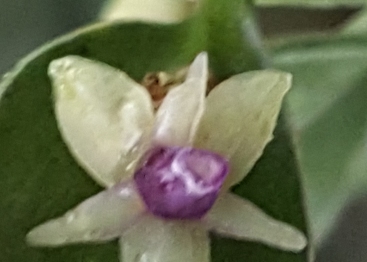
Also in the lane a
good number of common horsetail. Celandine were
starting to flower. My, what a morning and the moral
being, never let the weather put you off! Thanks to
all those who made the effort to turn out "
THURSDAY
JANUARY 18 - 2018
Emsworth
late afternoon walk
After a day
shopping and arting (in the Pallant Gallery) in
Chichester, I had a late afternoon walk to Nore Barn.
By the time I arrived (4pm) the tide was well out, but
the Spotted Redshank was still present feeding
in the low water channel downstream. I could not
resist taking a couple of shots of it in the late
afternoon sun.
Walking back round the
millpond I counted 36 Coot on the water. A fair
winter gathering, but far less than I have counted in
some previously. My record count was 186 in January
2011, but numbers have been generally below 100 in
recent years.

Most Coot stay in
Britain over the winter period and tend to form quite
large flocks at reservoirs and gravel pits, such as
Chichester Gravel Pits. These home based flocks are
added to by birds from Scandinavia, especially around
the southern coast, and the winter population can then
be up to half a million birds.
Pied Wagtails
were prominent around the edge of the pond as is
usual near dusk. They must roost somewhere local,
though I don't know where.

I found colour-ringed
Greenshank RG+BY feeding and preening in the
low water channel near the quay. This is an old friend
frequently seen in Emsworth Harbour. First seen on
04-Apr-13 and subsequently each winter in total 21
times.
This was one of 3
Greenshanks that Pete Potts and his team caught at
Thorney on 19-Mar-13 and fitted geolocators to the
blue rings. The geolocator has since been removed.
Langstone,
Nore Barn, Warblington
Peter
Milinets-Raby was "All over the place today, with gaps
in my schedule at odd times of the day" Here is the
report . . .
Langstone Mill Pond
from 8:57am to 9:32am - tide pushing in:
Off shore: 67 Brent Geese, 4 Red breasted Merganser,
38 Teal, 10 Wigeon, 91 Shelduck, 1 Great crested
Grebe, 1 Ad winter Med Gull.
Pond: Adult Grey Heron on lower Holm Oak nest.
Flooded horse paddock: At the rear in the bramble
hedge 1 Chiffchaff and 1 Firecrest.
12 Little Egrets. 1 Greenshank G//R + BR//-, 8
Black-tailed Godwit (one with colour rings WNG//- +
YRY//- Amazingly I have seen 46 individual colour
ringed Godwits, BUT not this one!!
7 Oystercatcher, 38 Teal, 2 Grey Heron, 11 Moorhen, 3
Pied Wagtails, 1 Stock Dove, 1 Green Sandpiper, 1
Curlew, 1 Redshank.
Nore Barn 12:12pm to 1pm - tide high, but
slowly dropping.
Roosting were 1 Redshank, 1 Greenshank and 2
Spotted Redshank (see below for details and
photos). 312 Brent Geese (all lovely and close by the
real Conigar Point and no Black Brant - however, more
importantly this flock contained 2 juvs). 51 Teal, 1
Kingfisher feeding from the trees that overhand the
water from Nore Barn Wood, 1 Great crested Grebe, 7
Shelduck,
By the real Conigar Point: 1 Skylark, 1 male
Reed Bunting, 9 Stock Doves.
Warblington 1:30pm to 2:16pm
Field west of the cemetery: 1 Cattle Egret, 8 Little
Egrets.
Field south of the cemetery: 42 Curlew, 15
Oystercatcher.
Field west of black barn: 311 Brent Geese. Contained 7
juveniles and one very dodgy goose that had about 30%
Black Brant in it.
Off Pook Lane: 1 female Goldeneye, A further 84 Brent
Geese close along the shore.
Two
Spotted Redshanks at Nore Barn
Peter
Milinets-Raby had two Spotted Redshanks during today's
visit to Nore Barn. It is not unusual to find two
there, but Peter provides photos to help distinguish
the regular bird from the occasional visitor. Peter
says the regular Nore Barn bird is the one with
darker, thinner loral streak through eye: wider white
eye-brow, extending further beyond the eye and a shade
darker than the other bird - the regular bird is on
the right.
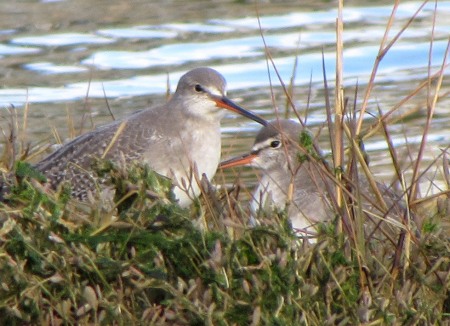
Peter checked my
recent video (Jan 14) and thinks this IS the regular
bird, the pale Spotted Redshank we sometimes see is
the intruder. See . . . https://youtu.be/yBWXtstAwes
Peter also got two
other nice photos one showing the two Spotted
Redshanks with the regular Greenshank G+GL and a
Common Redshank and the other with one of the Spotted
Redshanks having a big yawn!
Brian Lawrence also
got a shot of what looks like the regular Spotted
Redshank today.

I think the one I saw
later in the afternoon may have been the regular bird
too, though the light was poor - see photos above.
I
have a special page dedicated to the history of the
Spotted Redshank at Nore Barn and lots of photos
Go to . . .
Spotted
Redshanks at Nore Barn
Swans
at Bosham
Brian Lawrence
had a walk around Bosham yesterday and found a large
flock of Mute Swans. He counted 33 but may have been
more. Maybe that is where the Emsworth Millpond birds
have gone to?

WEDNESDAY
JANUARY 17 - 2018
Nore
Barn Greenshank
Russell Tofts
got this rather nice shot of the regular colour-ringed
Greenshank G+GL in flight at Nore Barn today. The left
leg green ring over the red marker ring can be seen,
but not the right leg rings.

Warblington
Peter
Milinets-Raby had another spare hour late this
morning, so popped down to Warblington 11:10am to
12:30pm - high tide and windy.
Even less geese today, so not surprising the Black
Brant did not show. I will have to check on the
weekend at low tide, when it is quieter. At least 7+
birders milling about scaring everything off, the
Brent were very jumpy! No idea where all the geese
have gone. I will have to do a complete check of our
area this weekend.
In field west of cemetery: 19 Little Egrets, 1 Cattle
Egret, 20 Oystercatchers,
In field west of black barn: 79 Brent Geese (no juvs
in this small flock). This flock was disturbed twice
in the hour I was present. They only flew to the
shore.
In field one further west from here (viewed from Pook
Lane): 49 Curlew - a good number
On the shore: 58 Brent Geese, 39 Wigeon, 1 Great
crested Grebe.
Cemetery: 1 Redwing, 1 Jay, 1 Sparrowhawk, 1 Green
Woodpecker.
Not very exciting.
TUESDAY
JANUARY 16 - 2018
Warblington
Peter
Milinets-Raby visited Warblington this afternoon from
1:30pm to 2:37pm: He could not find the Black Brant,
which was again reported today. His visit was as
follows:
Field to the west of the cemetery: 13 Little Egret, 1
Cattle Egret, 8 Oystercatchers,
In the field one further west: 10 Curlew.
In the field south of the cemetery: 231 Brent Geese.
The flock contained 3 juveniles (see photo). The birds
were beautifully spaced out and not a dodgy goose
amongst them.

Compared to
yesterday's total, there were 120 Brent missing,
obviously containing the Black Brant.
On the shore (high tide turning): 16 Brent Geese, 40
Wigeon, 21 Grey Plover, 109 Dunlin, 1 Great crested
Grebe, 4 Shelduck, 2 Red breasted Merganser, 2
Lapwing, 1 Black-tailed Godwit.
Don't forget to view
Peter's Report of the Birds of Warblington &
Emsworth 2017 at : https://peterspurplepages.wordpress.com/
MONDAY
JANUARY 15 - 2018
Langstone
Mill Pond
Peter
Milinets-Raby visited the Langstone Mill Pond late
this morning just as the rain eased 11:30am to
12:35pm. High tide. Here is the report . . .
Off shore: 7 Red Breasted Merganser. Only 6 Brent
Geese. The "flock" was on the fields at Warblington
where I counted 349 Brents.
Towards the end of my visit I heard a report of a
Black Brant at the Cattle Egret field. I looked
through the flock again, four times at least and could
not find anything in the flock. Mind you I was viewing
the field from the Langstone shore, so the bird could
be in the flock still. In the past I have picked out
Black Brant from here!! It must be the one reported
only a couple of times this winter from south Hayling.
The geese have only just started to use the fields in
the last two weeks and I personally believe that Black
Brant prefer grass to mud!! So it is certainly
possible. I noted that the north Hayling Field
viewable from Langstone was packed with Geese, at
least 400+. I think the Hayling flock have moved
north! No sightings of Black Brant from Hayling via
Andy Johnson. The bird maybe the one from Farlington
seen last week?
Here
is a shot of a Black Brant that Peter got a few years
ago at Warblington

1 Buzzard over the
Sweare Deep pestered by Lapwing. 12 Shelduck, 2 Great
Black-backed Gulls, Pond: Top Holm Oak. Watched the
pair of Grey Herons swap incubating duties. 2 male
Shoveler.
Flooded horse paddock : oozing birds!!! A record Teal
count of 162, An amazing 39 Little Egrets (not quite
my best count). 3 Grey Heron, 5 Wigeon, 1 Greenshank -
usual G//R +BR//-, 6 Oystercatcher, 3 Black tailed
Godwit, 1 Green Sandpiper, 15 Moorhen, 3 Pied Wagtail,
6 Redwing, 1 Chiffchaff at the rear hopping along the
fence vegetation.
SUNDAY
JANUARY 14 - 2018
Nore
Barn
I popped over
to Nore Barn at 12 noon - about 2 hours after high
water. The tide was still well in and the stream
fairly full. However, the ever faithful Spotted
Redshank was feeding as usual, first on the edge of
the stream, then among the seaweed on the shore as the
tide receded.
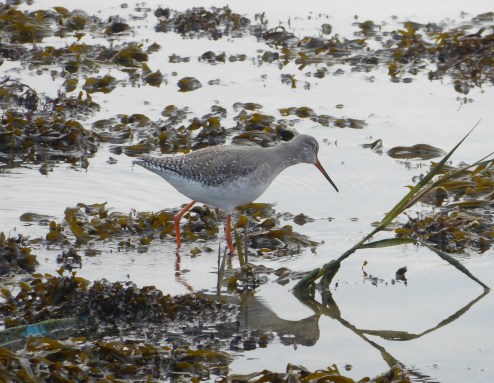
There was also a good
200 or so Brent Geese honking loudly at times in the
bay, before they all took to the air in a fine
spectacle that reminded me of a Peter Scott painting.
It was good to meet up with Neil Foster and his wife
(sorry forgot name) for a chat about birds and the
amazing longevity of the Saturday walks group.
I made a short video
of the Spotted Redshank feeding and Brent Geese in the
distance which can be seen on YouTube on the following
link . . . https://youtu.be/yBWXtstAwes
FRIDAY
JANUARY 12 - 2018
Langstone
Mill Pond
Peter
Milinets-Raby visited Langstone Mill Pond this
afternoon 1:14pm to 2:38pm - drizzle and low tide.
Here is his report . . .
Off shore: 97 Teal, 20
Wigeon, 21 Grey Plover, 187 Dunlin, 1 Knot, 4 Great
crested Grebe, 18 Black-tailed Godwit, 2 male & 1
female Goldeneye, 2 Turnstone, 1 male & 2 female
Pintail, 7 Red Breasted Merganser, 4 Lapwing, 84
Shelduck, 1 Bar-tailed Godwit, 4 Common Gull, 54 Brent
Geese - must be all on the fields on north Hayling! 1
Greenshank
Langstone Mill Pond: 2 Mute Swan, Grey Herons Top Holm
Oak - pair swapped round and checked and turned eggs
then sat down tight.
Flooded Horse paddock : (I had a Water Pipit here on
10th, but I could not find it today)
1 Black-tailed Godwit, 1 Redshank, 1 very nice looking
Curlew, looking surprisingly like a Curlew (probably
the same one that has been here all year). 1 Green
Sandpiper, 1 Meadow Pipit (probably the same as the
other day, feeding with the Water Pipit), 9 Moorhen, 1
Grey Wagtail, 3 Pied Wagtail, 6 Oystercatcher, 4
Redwing, Jay heard.
Birds
of Warblington & Emsworth 2017
Peter has
finished his Birds of Warblington & Emsworth
Report for 2017 which can be found at the following
link. It is in a pdf file format download. Any
comments welcomed. https://peterspurplepages.files.wordpress.com/2017/11/emsworthwarblingtonreport2017milinetsraby.pdf
WEDNESDAY
JANUARY 10 - 2018
Brook
Meadow
I had a walk
through Brook Meadow and down to Peter Pond on this
very pleasant morning with the sun shining and feeling
warm for a change. I half expected to see a butterfly,
but no luck. However, birds were singing as if it was
spring, including Woodpigeon, Wren, Carrion Crow and
several Robins, one of which I managed to
capture on camera.

Hazel catkins
are now fully open in the north-east corner of the
north meadow.

The Gorse bush is in
full blossom on the causeway . . .

from where one gets a
nice view of the tall, leafless and very pale Black
Poplar trees.
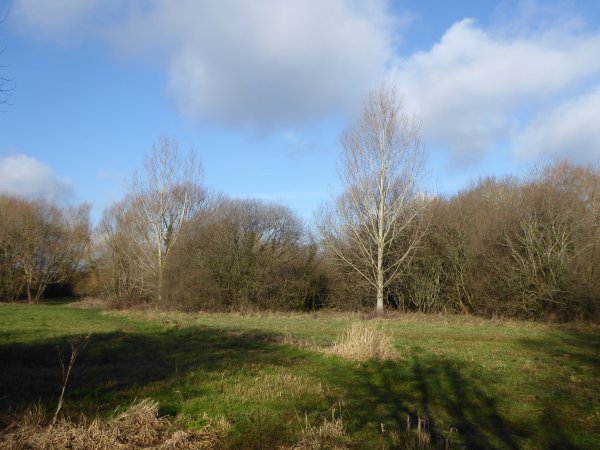
I was surprised to
find 6 Mallards (4 males and 2 females) in the
Lumley pool, having strayed from their regular haunt
on Peter Pond. They will be getting frisky any time
now.

Coming back towards
home along Bridge Road I was not surprised to see a
few flowers of Lesser Stitchwort snuggled
underneath the old Beech hedge. They must have been
flowering all winter.

Godwit
showing 'rhynchokinesis'
Ralph Hollins
passed on details of a Black-tailed Godwit with a
flexible upper mandible, called 'rhynchokinesis' seen
and photographed at Arlington Reservoir in Sussex on
Jan 7. Rhynchokinesis is defined as a form of jaw
mobility found in some birds in which the end of the
upper mandible can be raised or lowered independently
of the rest of the bill. Is this an advantage to the
bird or a deformity?

Goldeneyes
The BTO says
January is the peak month for seeing Goldeneyes.
Favouring large lakes, gravel pits and sheltered sea
bays, Goldeneyes can be encountered throughout Britain
and Ireland in the winter months. If present in mixed
sex flocks, it is possible to see the male Goldeneye
performing their striking courtship display . . .
http://bto-enews.org/NXN-5DD78-3GJW16-2YBUXD-0/c.aspx
Here is a nice
shot of two males and a female Goldeneye by Derek
Mills at Fareham

Goldeneye was only
recorded breeding for the first time in Britain as
recently as 1970. Since then, the population has
expanded, with the aid of special tree mounted nest
boxes, and now numbers around 200 pairs. The majority
are found in the Speyside region of northern Scotland
with breeding records from Chew Valley, Somerset and
Northumberland, and summering birds occurring
elsewhere.
SUNDAY
JANUARY 7 - 2018
Brook
Meadow work session
I went over to
the meadow this morning for the regular 1st Sunday in
the month work session. It was bright, but cold with a
biting northerly wind. 11 volunteers assembled at the
new tool store for the initial briefing by Maurice
Lillie.

The main job was to
rebuild the dead wood fence near the S-bend. Sticks
were collected from different parts of the meadow and
also cut from the Osiers. They will sprout afresh.

During the work, one
group of volunteers came across a cluster of
Jew's Ear fungi growing on the end of a small
twig.

Car
park litter picking
When I got
back from Brook Meadow this morning I decided to
continue the litter picking in Bridge Road car park
that I started yesterday. Litter was literally
everywhere in the car park, beer cans, plastic
bottles, wrappers and take-away coffee cups and lots
of other messy stuff. It's amazing what people chuck
out of their car windows. I collected no less than 6
large bags full of rubbish plus an old lorry tyre.

In fact, Norse (HBC
that was) do collect litter from Bridge Road
immediately outside the car park, but don't do the car
park itself. I think it must have something to do with
the designation of the grass wayside as a wildlife
conservation area. This is silly and I am hoping to
persuade Norse to alter the litter pickers routes to
include the car park.
Emsworth
to Langstone
Peter
Milinets-Raby walked from Emsworth to Langstone Mill
Pond this morning and was joined at Nore Barn by John
Norton. His report follows . . .
"I started at Beacon
Square at 7:45am (20 minutes before sunrise): 72 Brent
Geese, 51 Dunlin.
Emsworth Harbour: 26 Dunlin, 2 Grey Plover, 56 Canada
Geese by the town and all left before the sun came up.
8 Teal, 9 Turnstone, 3 Greenshank, 14 Lapwing, 148
Brent Geese, 1 Ringed Plover, 34 Shelduck, 4 Red
Breasted Merganser, 6 Knot, Colour ringed Redshank
(-//G + G//YG) - usual bird.
On Emsworth Mill Pond: 1 Goosander, 2 Cormorants. I
did not count the Coot, as the bitter north east wind
was impossible to deal with!!!
Nore Barn from 8:34am: Tide too far out for any decent
counts. 45 Wigeon, 8 Teal, 34 Brent Geese, 8 Shelduck,
2 Grey Plover.
Warblington from 8:50am: 1 Cattle Egret with 14
Little Egrets in the field west of the cemetery,
though they did all walk through holes in the hedge
and go into the field west of the black barn, when the
cattle wandered into this field! 4 Redwing in trees in
cemetery.

Rotting Wheat mound in
big field behind Conigar Point: 3 Pied Wagtail, 7
Meadow Pipits, 1 Water Pipit - eventually showed well
in the scope alongside 3 Meadow Pipits. 1 Grey
Wagtail, 9 Skylark, 15 Stock Doves.
Conigar Point: 6 Wigeon, 9 Brent Geese,
Off Pook Lane: 1 male
and 2 female Pintail, 10 Grey Plover, 2 Greenshank, 51
Brent Geese with 3 juvs. And 6 in the field south of
the cemetery - low numbers as most were on North
Hayling fields. Adult winter Mediterranean Gull, 48
Shelduck, 12 Red Breasted Merganser, 2 Great Crested
Grebe,1 Bar-tailed Godwit, 3 Turnstone, 4 Black Swan -
they were swimming from the east and then settled down
in one of the gullies near the Wade Lane path - tide
slowly coming in. 120+ Dunlin.
Wade Lane from 10:42am to 11:35am. 2 Little Egret, 1
Mistle Thrush.
Flooded horse paddock
north of Langstone Mill Pond: 1 Green Sandpiper, 5
Oystercatchers, 2 Redshank, 1 very nice looking
Curlew, Male Kestrel, 2 Pied Wagtails, 4 Moorhen, 5
Redwing (see photo), 3+ Song Thrushes.

Langstone Mill Pond: 2
Teal, 1 Little Grebe.
Off shore by the pub - Pook Lane: 103 Teal, 11 Common
Gull, 2 Sandwich Tern, Plus probably the same adult
winter Med Gull from earlier.
And the usual colour ringed Greenshank in the stream
outflow - G//R + BR//- No tag now. Did we ever get
info back on this bird???
Godwit
update
Anne de Potier
says the Black-tailed Godwits have pretty much
vanished from our shore. As is typical at this time of
year after a lot of rain they have relocated to the
north side of Pagham Harbour. This afternoon she found
ROL+RLR and several of the others that have been seen
locally this autumn feeding busily in the creek just
below the Salthouse as the tide rose. Fortunately she
was able to stand in shelter and feel warm!
Black
Swans
Christopher
Evans got a photo of the 4 Black Swans at Langstone
this afternoon. These are presumably the same birds
that Peter Milinets-Raby reported this morning.

THURSDAY
JANUARY 4 - 2018
Millpond
birds
I struggled
along the main promenade by the town millpond this
morning against a fierce SW wind. A Little
Grebe was fishing in the harbour by the seawall,
buffeted by the waves. Meanwhile, on the calmer waters
of the millpond itself a male-female pair of
Red-breasted Mergansers were fishing and
displaying - the first I have seen here this winter,
though they are regular winter visitors.

Finally, to crown it
all, coming back along Bath Road I had an excellent
view of the juvenile Goosander fishing and
preening. It has now been on the millpond and
surrounding waters for the past 6 weeks since it was
first seen by Peter Milinets-Raby on 16-Nov-17. Here
is a selection of shots I got of the Goosander
preening and swimming.
Here is a link to a 1
min 30 sec video clip on YouTube of the Goosander
busily preening itself . . . https://youtu.be/Z2fg7yKM4fk
WEDNESDAY
JANUARY 3 - 2018
First
Celandines
It was pleased
to see my first Lesser Celandines of the year in
flower on the bank of the Westbrook Stream as I walked
through Bridge Road car park this morning. I had my
camera, so snapped them.

This is quite early,
though Ralph Hollins spotted his first Lesser
Celandines on Hayling Island way back on November
14th, which is his words were "probably the earliest
of my life!"
Winter
Red Admiral
I also spotted
a Red Admiral fluttering around the garden this
afternoon. Although it was sunny the air temperature
at 10 degrees C was pretty chilly. I did not get a
photo, but here is a late flying Red Admiral that
Malcolm Phillips got on Brook Meadow a few years ago.

Large numbers of this
attractive butterfly migrate here from N Africa and
continental Europe each spring and summer. The
immigrant females lay their eggs producing a fresh
emergence of fresh Red Admirals from July onwards.
They continue flying into October or November, but
very few manage to survive our winters, except here in
the far south where we are privileged to live. The Red
Admiral has for some time been regarded as an
all-the-year-round butterfly.
Marine
life at marina
John Arnott had a walk down to Great Deep this
afternoon and on the way went through Emsworth Yacht
Harbour where lots of pontoons were out of the water
while the Yacht Harbour is being dredged. These
pontoons were encrusted in calcareous tube worms,
hydroids (sea firs), bryozoans (sea mats), sponges,
sea squirts, a few barnacles, some mussels and a few
oysters (Pacific unfortunately). John did not have his
camera but thought it is a fascinating opportunity to
see marine life that is normally hidden from us.
He thinks the tube worms may be the same species that
grow on Slipper Millpond. These are called Bristle
Worm (Ficopomatus enigmaticus) which can
be seen as coral-like structures when the pond is
drained.

Unusual
Pheasant
Chris Oakley
sent a photo of an unusually coloured Pheasant that
has appeared in his friend's garden in Nutbourne and
wonders if anyone knows why it is that colour.
Moulting, maybe?

TUESDAY
JANUARY 2 - 2018
Warblington
Cattle Egret
Today, Peter
Milinets-Raby decided to have another look at the
settled Cattle Egret. Peter reports . . .
"The Cattle Egret now has a favoured field as the
farmer has at long last moved the cattle into the
field west of the cemetery. Still very flighty, as are
the regular wintering flock of 16 Little Egrets. The
birds spook easily. Well, with two reports of this
bird on Going Birding in as many days, I wasn't
surprised to find nine very wet birders wandering
around the farm looking in vain for the egret. It
wasn't on show, probably seen by the first long gone
birder on the scene, flushed as is its tendency and
disappeared into the big field to the east of the barn
and thus out of sight! I had a quick chat and decided
to go elsewhere away from the crowds!"
Here is Peter's
photo from last week - taken from the car, one quiet
morning.

Peter also had a walk
along Langstone Mill Pond. He reports . . .
"I was rewarded with a Black-throated Diver (my
first in this area and obviously will have to go in
next years report!!!!). The bird was really close to
start, then moved further out. When it was under the
water, it emerged yards away, so was very mobile. I
note that two were seen off Broadmarsh this morning,
so it could be one of these, but it could just as
likely be the one from Black Point area. The Hayling
Bridge is a bit of a barrier, but you never
know."
Other birds of note
were - high tide, 8 Shelduck, 17 Dunlin.
Pond: Grey Heron seen mating again on the top of the
Holm Oak. I wonder if the first clutch failed, as the
birds have been together on this nest for the last
week.
There was nothing else on the pond. All the birds were
in the flooded horse paddock: 67 Teal, 14 Little
Egret, 5 Grey Heron, 14 Moorhen, 8 Wigeon, 5
Black-tailed Godwit, 5 Oystercatcher, 1 Redshank, 3
Pied Wagtails, 19 Mallard.
MONDAY
JANUARY 1 - 2018
Emsworth
Harbour
Peter
Milinets-Raby had an unhurried walk (with just a pair
of binoculars) around Emsworth this afternoon, even
stopping off for coffee and ice cream (he had his son
Aleksandr with him): From 12:48pm (still drizzle at
this point) until 2:45pm Peter saw the following:
Nore Barn: (Tide still in, so little to see): 227
Brent Geese, 2 Cormorants, Male Red Breasted
Merganser.
Then we walked from Beacon Square around the Mill pond
to the cafe: Beacon Square: 47 Brent Geese, 1 Sandwich
Tern, On the way back when the tide dropped - 50+
Dunlin.
Emsworth Harbour: 1 Sandwich Tern, 2 Little Grebe, 1
Great Black-backed Gull, 1 Skylark passed over, 3
Greenshank along the wall by the town, On the way back
when the tide dropped - 30+ Dunlin, 2 Grey Plover and
a Kingfisher perched on one of the yachts.
Emsworth Mill Pond: First winter Goosander
showing well a couple of times - can be very confiding
- see photo. 1 Little Grebe.

Back at Nore Barn: -
just too busy with thousands of dogs (oh, and yes
people) and tide well out: Redshank and a Dunlin in
the stream - nothing else. Duck flighty - 40+ Wigeon,
20+ Teal and 2 Shelduck.
Noting down everything (well it was Jan the First), I
actually saw a total of 46 species during my short
little walk. Happy New Year!
For
the previous month go to . . . December
1-31